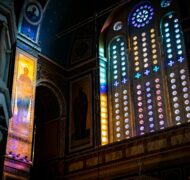Church Buildings
Book / Produced by partner of TOW
The English word church is derived from the Greek adjective kyriakos implying a place of Christian worship. In the New Testament, however, church is translated for ekklēsia, which means “a local congregation” and not a building. In the earliest manifestations of ekklēsia there was no confusion, for there were no special buildings designated as places of Christian worship. In the first century early Christians met in the most immediately available structures, that is, their own homes. The earliest-known extant Christian sanctuary was a private house in Dura, Syria, dated in the early third century.
A case can be made for maintaining this arrangement today. Churches that do not own real estate are often able to invest their resources in ministry more effectively and extensively. The lack of permanent facilities also combats the debilitating illusions of comfort and permanence, which might otherwise be realized. Without a building the ekklēsia is composed of “living stones” rather than bricks and concrete. Currently there are many examples of congregations who function effectively without a building. These congregations without buildings are often innovative and well targeted to the ministries to which they feel called. The house church movements in many parts of the world are examples of this approach.
Origins of Church Buildings
As early churches grew and liturgy developed, the homes in which ekklēsiai met were adapted to suit the congregation’s use. By the fourth century buildings were being separately constructed for Christian worship, adapting the basilica form used in pagan worship. After the Reformation, meeting houses provided an alternative form. The model of auditoriums has provided an alternative in the twentieth century. Until the twentieth century, church structures have dominated the landscapes of Western civilization. In recent times the university, the hospital and the shopping mall have come to more accurately represent the priorities of our culture.
A majority of contemporary congregations are accommodated in buildings built for the purpose. These buildings have a powerful influence on the life of the local church. The building determines to a large extent the activities in which the congregation will engage, its perception of itself and the allocation of its resources. The lack of flexibility in many church designs actually prevents congregations from activities to which they feel called. It is important for the ekklēsia to examine its essential nature and its mission, as the building that accommodates it is a powerful influence capable of reinforcing or frustrating the expression and perception of the life of the congregation.
Meaning of Church Buildings
What our buildings say about the congregations they accommodate and the way they shape us needs careful examination. Many of the current trends in church design have a relatively recent history and are borrowed from secular building types that may be based on inappropriate assumptions about the nature of the activities they accommodate.
An impartial examination of the main gathering space of many church designs would indicate that the life of the ekklēsia is primarily one of individuals consuming live entertainment or educational services. Many are designed to facilitate the production of electronic entertainment as well. This assumption extends to the buildings of most Christian traditions, with the performance of the presider at the altar the focus of observation in sacramental churches and the preacher in the pulpit or worship team and overhead projector seen on the stage in others. The building form determines the nature of the activity within it and forms the expectations and self-image of those who attend. The fact that many structures will be used no more than a few hours per week implies that this type of building is exempt from the criteria of effective stewardship of financial and physical resources, which we would apply to most other enterprises.
The use of pews is a relatively recent custom in the history of the church. This type of permanent seating usually means that only one type of activity can take place in the room. The permanence of the arrangement ensures that the possibilities of variation even within the broad category of worship will be limited. Many congregations are finding new life in apparently obsolete church buildings by removing this type of seating in favor of individual, movable seats. There is a growing trend for new churches to be equipped with movable seating. In some cases this seating is arranged in a semiwraparound form rather than in serial rows, allowing more participation to take place and some interaction between the members.
In our culture communications are increasingly influenced by symbols. Church buildings are symbols that need to be used carefully. For many in the community, a church building is the primary source of information about the congregation within. It has been said that some ekklēsiai are private clubs run for the benefit of its members. The building can communicate this by insensitivity to its surroundings, lack of adequate parking, uninviting and difficult-to-find entrances and other features that indicate it is closed to nonmembers. It is alternatively possible to indicate to the local community the existence of a welcoming, open-ended, serving, hospitable worshiping community that is active and open for the business of the kingdom of God.
Spaces Within Church Buildings
Christians have been endowed with powerful and corporate actions such as baptism and Communion. The character of these symbols is often not exploited in our buildings. Many traditions are becoming aware of the power of Christian worship as practiced in the ancient church of the third and fourth centuries.
Baptism was usually carried out on Easter eve. The baptistery was often a pool in the entry courtyard of the house in which the congregation met. The candidate would go down into the water (identifying with Jesus in his death) from the street-entry side of the pool and rise out on the other side of the pool (a participant in Christ’s resurrection) to enter directly into the meeting room of the ekklēsia as a full member of the company of the redeemed. The association of the baptistery with the entry to the sanctuary has a number of symbolic possibilities.
Similarly the Lord’s Supper was seen as a community event in which the presider hosted the celebration with the congregation as active participants. The simple expedient of arranging seating so that worshipers can see one another’s faces can emphasize the nature of a congregation as a group related to one another because of their being guests at the same meal.
If the function of a local congregation requires the development of a building, it presents a great opportunity to understand and express the ekklēsia’s nature, function and values. The building will help them remind themselves and communicate it to others.
» See also: Church
» See also: Church in the Home
» See also: Church Structures
» See also: Fellowship
» See also: Mission
References and Resources
R. Bowman, When Not to Build (Grand Rapids: Baker, 1992); M. Mauck, Shaping a House for the Church (Chicago, Ill.: Liturgy Training Publications, 1990); R. Messner, Building for the Master (Wichita: RAM Media, 1987).
—Rodger Woods





